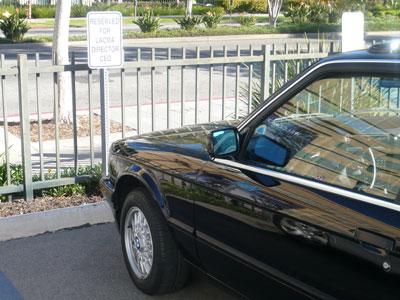Pulling into the parking lot at LACMA one morning I noticed the museum's director, Michael Govan, placing a brand-new California license plate onto a tan-colored, 1989 BMW 325is. After the initial shock of watching him use hand tools in his impeccable suit wore off, I asked him about the car. He explained that he had recently had it shipped to Los Angeles from New York City and was considering having it custom painted. He noted that it was very similar to my own 1991 BMW 325i. "You drive that little black one, right?" As it turns out, Michael appreciates cars, and now that we had ours in common, he would, from time to time, update me on the progress of his. Turns out the custom paint was being created with art fabricator and artist Jack Brogan in an unassuming warehouse in Inglewood where, along with tricking out Michael's car, Brogan has been collaborating with Robert Irwin on a series of highly polished and gorgeously colored large-scale paintings on honeycomb aluminum. Intrigued, I recently sat down with Michael to find out more...
[caption id="attachment_2654" align="aligncenter" width="400" caption="John Bowsher, Jack Brogan, and Robert Irwin"]
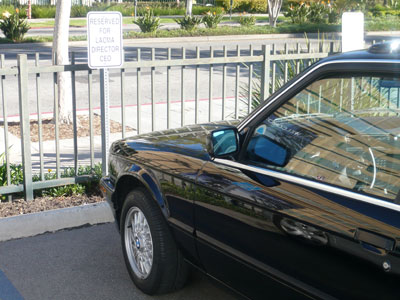
MT: Let's talk about your fabulous car.
MG: So hilarious that you're here to talk to me about that.
MT: Who painted it?
MG: Jack Brogan—he's a legend in Los Angeles. He was one of the key collaborators of the Southern California artists, who some people called finish-fetish artists, or conceptualist artists. In particular, he worked since the early 1960s with artists like Robert Irwin and Larry Bell. He often restores artworks; in his studio now is a Calder from San Diego, and a Larry Bell, and a Craig Kauffman. Whenever anything has to be done that is super precise, or requires unusually refined surfaces, you call Jack; he's a genius at that. He is currently working with Robert Irwin on a series of new paintings that were just shown at Pace Gallery. The surfaces of the black painting I saw recently is so perfect that to see it is to look into another world. While it's incredibly reflective, it's very different from looking into a mirror.
MT: And how did you find him?
MG: The simple story is that I was sick of making car payments on new cars that I mostly didn't love anyway, and since I only drive two miles to work every day, and occasional meetings, it seemed a waste to have a new car. I was toying with the idea of bringing my old car that was stuck in a garage in New York. I had to move it anyway, so I thought maybe I'd bring it out here.
John Bowsher, LACMA's director of special art installations, who was with me in New York and had ridden in that car up to Dia:Beacon many times, said, "You can't bring that color to L.A. It's not an L.A color." It was BMW's ‘80s "Bronzit" beige color. I had never liked the color anyway. A few days later John said, "You've got to change it, and I got it all set up. I talked to Jack Brogan." I had known Jack through his friendship and association with Irwin.
Anyway, I went over to Jack's and he showed me all the work he was doing with Bob Irwin—we spent probably an hour and a half just talking about color, and paint color, and he showed me what he was doing with metal paint. Long story short, he said he'd be happy to work on the car for me, and work on the color.
-
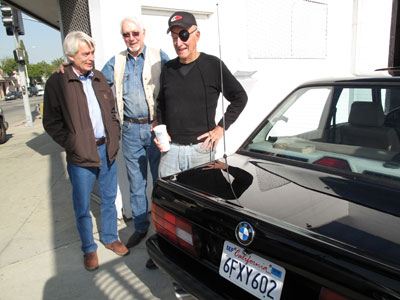
bmwpeople400[/caption]
MT: Had he done cars before?
MG: Yes. Even his Chevy Suburban, you'll notice, has been subtly lowered, and all the trim has been removed. So it's not screaming "custom" at you. The first thing he asked me, jokingly, was whether I wanted flames painted on it.
MT: You didn't get the flames?
MG: I didn't get the flames. He's restored many, many cars. Have you ever read Seeing is Forgetting the Name of the Thing One Sees, which is Lawrence Weschler's biography on Robert Irwin? In it is a wonderful section that talks about the artist and car culture. Bob argues with an art critic about aesthetic practice by showing him the many aesthetic decisions that go into a car restoration. Bob, like several of his contemporaries in L.A., restored cars himself. It was all part of the artists' scene that he and Jack inhabited in Los Angeles in the 1950s and ‘60s.
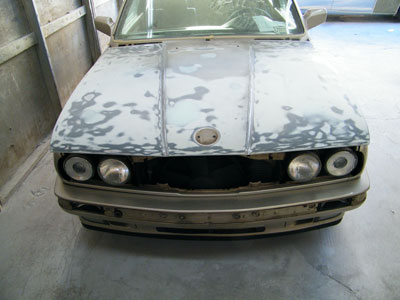
bmwbefore4001Work in progress
MT: You told me once before that Jack said he didn't do foreign cars.
MG: He doesn't in general work with foreign cars, so at first he looked a little askance at my BMW. By the time we were done, he was driving it himself every day, and quite liked it. We picked the color, which is actually a deep blue, so when it's in the California blue sky, you really see the blue. Most people would say that it's black. But at night, blue-black is even darker than black. It's a really, really beautiful color.
MT: Why did you choose this car in the first place?
MG: I bought the car in 1994, when it was already five years old, in Long Island. I had actually just seen it on the street in East Hampton, and took down the number; I loved the square shape of that BMW. It turned out it was owned by the girlfriend of a guy who is the "car doctor" of eastern Long Island, Ryan Pilla. He is the "car doctor" to auto enthusiasts, car collectors, and celebrities. He offers car racing vacations, he races motorcycles, cars, and he takes care of Jerry Seinfeld's car collection, among others.
MT: Did you really install woofers and a sound system?
MG: Well the problem was that the wires had rotted out. So we needed new speakers, and I didn't want to change the look of the stock speakers, so in order to get any quality sound we had to put in the amp and the sub-woofer.
MT: That's so L.A.
MG: It doesn't sound as good as a new car, but it sounds really good for a little car like that. And I put in the performance chip.
MT: What's that?
MG: These are some of the first cars that have computer-controlled electronic ignition, so you get fifteen more horsepower if you reprogram the ignition; I did it myself for fun.
MT: You did it yourself?
MG: Yeah. It was kind of cool: you had to replace the chip from underneath the glove box; I read all of the instructions. It was my little Saturday morning project. I was half-sure it was going to blow up when I turned the ignition, but it worked. Jack hasn't driven it since the performance chip, and he's got a little touch-up to do.
MT: Are you just ecstatic now for having brought it out, because you can drive it more now that you're in Los Angeles?
MG: Right, now it's exciting. And I bought a bicycle too so that I can ride that to work when the car is in the shop, as old cars can be. Actually Bob Irwin said that I had finally moved to Los Angeles. I had gone through my rite of passage: I had customized my car. I customized it in just that way where most people don't quite know that it's not stock. It's more fun. It's an '89, so it's a super boxy car. Today almost every single car on the road is curved or chiseled, so it stands out.
MT: I want to go back to your discussion about the color. What was that like?
MG: Jack was working on his and Bob's dark paintings, so we were talking about the nature of dark colors; I definitely wanted it dark. I thought that the body shape looked better when it was dark; everything pulled together with the tires and the trim. It had a light tan interior that I thought was ok, so we just cleaned it up a little bit.
The greens, reds, and blues of the paintings were really deep and dark. I loved the blue because it held the sky somehow, the L.A. sky. We started looking in that family of colors. Jack came up with something new and special for the car. Bob Irwin said that he liked the color so much he might use it for a painting. We'll see.
MT: Was Bob satisfied with the end result?
MG: I think he was, yes. He was skeptical at first since he has such high standards in these matters. But I think he was quite surprised and impressed.
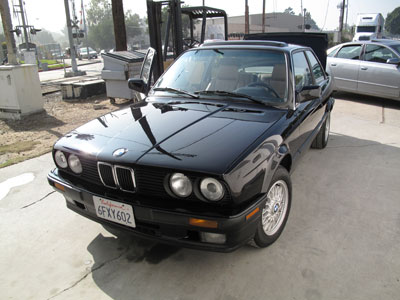
bmwafter4001989 BMW 325is
MT: Did you go to see Jack specifically with the intention of asking him for the car color?
MG: Jack already knew that I was coming because of John, and I knew him through Bob. He didn't paint it himself; he mixed the color, and ended up having someone else paint it. And they did a great job. It's almost "cherry," as Bob Irwin would say. Perfect.
Marietta Torriente de León, Major Donor Event Planner



